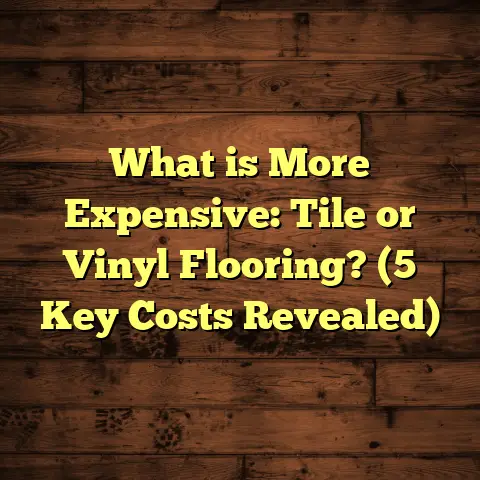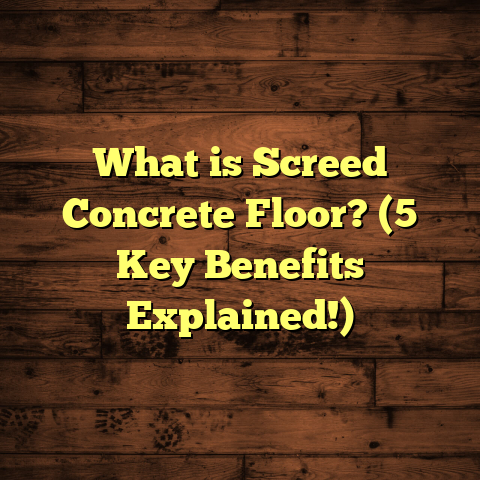What is LVP vs. Engineered Wood Flooring? (5 Key ROI Insights)
Smart Living and Flooring Choices: Why It Matters to Me
When I think about smart living, I think about making choices that blend style, comfort, and practicality without breaking the bank. Flooring is a huge part of that. It’s not just about how your floors look; it’s also about how they perform, how long they last, and what kind of return you get when you decide to sell your home or upgrade again. Over the years, I’ve worked with all sorts of flooring materials, but two that always come up in conversations are Luxury Vinyl Plank (LVP) and Engineered Wood flooring. They’re both popular for different reasons, and I want to share what I’ve learned personally and professionally about these two options.
A lot of people don’t realize how much the right flooring can change the vibe and functionality of their space. Whether it’s a cozy family room or a high-traffic kitchen, the flooring choice impacts everything from foot comfort to cleaning routines. When I started working in flooring, I quickly noticed that clients were often confused between LVP and engineered wood. They sound similar but have very different benefits and drawbacks. So I decided to put together this overview based on years of firsthand experience, client feedback, and digging into research.
If you’re thinking about upgrading your floors or building a new place, this should help you get a clearer picture and make a confident choice.
What is LVP and Engineered Wood Flooring?
Let me break it down simply: LVP stands for Luxury Vinyl Plank. It’s a synthetic flooring material designed to mimic the look of real wood, but it’s made from layers of vinyl and other composites. It’s water-resistant, durable, and pretty easy to install.
Engineered wood, on the other hand, is a real wood product. It has a top layer of hardwood veneer glued onto multiple layers of plywood or high-density fiberboard underneath. That gives it more stability than solid hardwood, especially in areas where humidity changes are common.
I remember working on a project where the client was torn between these two. They loved the authentic look of wood but worried about moisture damage in their basement. That’s when understanding these differences really helped them make a decision.
Luxury Vinyl Plank (LVP)
LVP is made up of several layers:
- Wear Layer: This is a clear protective coating that guards against scratches, stains, and daily wear.
- Vinyl Layer: Underneath the wear layer is the photographic vinyl layer that mimics natural wood grain.
- Core Layer: Provides stability and impact resistance. Some cores are rigid (like WPC or SPC), which add extra durability.
- Backing Layer: The bottom layer adds support and moisture resistance.
Because it’s vinyl-based, LVP naturally resists water better than wood products. This makes it perfect for kitchens, bathrooms, basements — places where moisture is an issue.
Engineered Wood Flooring
Engineered wood is constructed differently:
- Top Veneer Layer: A thin slice of real hardwood, usually 2-6 mm thick.
- Core Layers: Multiple layers of plywood or high-density fiberboard stacked and glued crosswise. This structure improves dimensional stability.
- Backing Layer: The bottom layer balances moisture and temperature changes.
The real wood veneer means that engineered wood offers the genuine look and feel of hardwood floors while being more stable against warping than solid wood.
The difference in construction means each floor behaves differently once installed.
1. Cost vs. Value: What Will You Get Back?
One of the biggest questions homeowners ask me is about return on investment (ROI). How much bang do you get for your buck when choosing between LVP and engineered wood?
Initial Costs
LVP flooring generally costs between $2 to $7 per square foot for materials, with installation adding roughly $1.50 to $3 per square foot. So if you have a 1,000-square-foot area, you might spend anywhere from $3,500 to $10,000 total.
Engineered wood usually runs higher — $4 to $10 per square foot for materials and $3 to $6 for installation. This can push the total cost for that same 1,000-square-foot space between $7,000 and $16,000.
I recall a job where the homeowner had a fixed budget but really wanted the wood look. We compared options carefully using a detailed cost breakdown with labor pricing included. After factoring in everything, they decided on mid-range LVP to stay within budget without sacrificing style.
Resale Value
According to a 2023 Remodeling Magazine Cost vs. Value Report:
- Upgrading to engineered wood flooring recoups about 70% of your investment at resale.
- LVP recoups about 60%.
To me, this means engineered wood can add more value if you plan to sell your home in the near future. But don’t take this as gospel — resale values depend on your local market too.
Long-Term Savings
While LVP costs less upfront, its durability means fewer repairs or replacements over time — especially in wet or high-traffic areas.
Engineered wood might require more care or occasional refinishing (depending on veneer thickness), which adds to long-term costs.
I once had a client who stayed in their home for 10 years after installation. Their engineered wood still looked great but needed minor touch-ups midway through those years. Another client with LVP had zero issues during the same timeline.
What’s Your Timeframe?
Ask yourself: How long do you plan to keep this flooring? If it’s short term (under 5 years), LVP often makes more sense financially.
If your goal is to boost home equity over many years, engineered wood might pay off better.
2. Durability and Maintenance: Which Stands Up Better?
If you have kids or pets running around like I do, durability is a huge deal.
How Tough Is LVP?
LVP is tough stuff. It’s scratch-resistant, water-resistant, and holds up well in high-traffic areas. I installed LVP in a client’s kitchen that floods occasionally due to plumbing issues. After five years and multiple spills, their floor still looked brand new.
Manufacturers often rate the wear layer thickness in mils (thousandths of an inch). A thicker wear layer means better scratch resistance:
- Residential wear layers: 12-20 mils
- Commercial wear layers: 20+ mils
For heavy use areas like hallways or kitchens, I recommend no less than 20 mils.
Engineered Wood Durability
Engineered wood is strong but not waterproof. It can handle normal wear but will scratch or dent more easily than LVP.
Spills need quick cleanup to avoid damage — standing water will eventually ruin it.
I advise clients to use area rugs in dining rooms or play areas to protect these floors.
Special Maintenance Tips
- LVP: Sweep regularly; mop with damp cloth occasionally using manufacturer-approved cleaners.
- Engineered Wood: Use hardwood floor cleaners; avoid water pooling or steam mops; refinish only when veneer thickness allows.
Personal Experience
A family with two dogs called me after buying LVP because they loved how easy it was to clean muddy paws off compared to their friends’ hardwood floors.
On another job, an elderly couple picked engineered wood for their living room because they loved the feel underfoot but agreed on strict cleaning routines to keep it looking sharp.
3. Installation Flexibility: What’s Easier?
Installation plays a big role in time and labor cost — something I always explain clearly to clients.
Installing LVP
LVP is often a floating floor with click-lock planks that are simple enough for DIYers to tackle on weekends. The planks snap together without glue or nails.
In fact, I helped a homeowner install LVP in their basement themselves over one weekend, saving hundreds on labor costs.
LVP can be installed over various subfloors including concrete slabs — perfect for basements or renovations without much demolition.
Installing Engineered Wood
Engineered wood can also be installed as floating floors if they have click systems but often requires glue-down or nail-down methods depending on subfloor type and manufacturer recommendations.
This usually means hiring professionals unless you have experience with woodworking tools.
On one commercial project, we had to glue down engineered planks due to building codes — which added labor time but gave excellent stability.
Subfloor Prep
Both materials require level subfloors but LVP is more forgiving on minor imperfections because of its flexible core layers.
Engineered wood demands more care in subfloor prep because unevenness can cause squeaks or plank movement over time.
Time Investment
If you’re short on time or skill level for installation, LVP is often your best bet — it allows faster completion with fewer headaches.
4. Appearance and Feel: Can You Tell the Difference?
This one comes down to personal taste.
Natural Look
Engineered wood looks exactly like hardwood because it is hardwood on the surface. The grain patterns and texture are natural and warm underfoot.
LVP has come a long way in appearance thanks to high-resolution photographic layers and textured finishes that replicate real wood surfaces almost flawlessly.
However, if you run your hand over LVP planks alongside real wood flooring, you’ll feel the difference — LVP tends to feel slightly softer and more plastic-like.
Visual Variety
Both come in tons of colors and styles — from rustic oak to sleek hickory — so you can find something that fits your home’s vibe perfectly.
I’ve seen some high-end LVP collections that look downright stunning in modern homes with wide planks and matte finish textures.
One client chose engineered wood for their main living room because they loved the depth of grain variation but used LVP in their mudroom where function beat form.
Aging Over Time
Engineered wood develops character as it ages — minor scratches or color shifts add warmth many homeowners appreciate.
LVP keeps its look consistently because it’s synthetic — some people prefer that “like new” appearance longer term.
Comfort Underfoot
Engineered wood tends to feel warmer and more solid when you walk on it due to its dense natural structure.
LVP may feel slightly softer or springier depending on core type but generally cooler since it doesn’t retain heat like wood does naturally.
5. Environmental Impact: What About Sustainability?
This topic matters more than ever for me personally as I try to make smarter choices that don’t harm the planet unnecessarily.
Engineered Wood and Sustainability
Engineered wood uses real wood but less than solid hardwood floors do because it’s made by layering thin veneers over plywood or fiberboard. This means more efficient use of timber resources than solid hardwood floors do.
Many engineered wood manufacturers source timber from responsibly managed forests certified by organizations like FSC (Forest Stewardship Council).
LVP Environmental Concerns
LVP is mostly plastic-based — often PVC — which raises concerns about chemicals used during production and challenges with recycling at end-of-life.
However, many manufacturers have started improving formulas by reducing volatile organic compounds (VOCs) and increasing recyclability efforts.
Some brands offer LVP options made partially from recycled materials too.
Energy Use
Production of synthetic flooring like LVP tends to be less energy-intensive than milling hardwood but isn’t biodegradable after disposal.
On balance:
- If sustainability ranks high for you, engineered wood might edge out due to natural materials.
- If durability and water resistance are critical (e.g., basement floors), LVP may reduce waste long term by lasting longer without replacement.
More Insights From My Projects & Research
Case Study: Family Home Renovation
A family with two young kids wanted durable floors that would survive spills and rough play but still look stylish for entertaining guests. They also had budget limits.
We compared mid-grade LVP vs engineered wood with thin veneer:
- Initial cost: $6K vs $11K
- Estimated resale recoup: 60% vs 70%
- Maintenance effort: Low vs medium
- Installation time: DIY weekend vs pro install + 1 week drying
They went with LVP for peace of mind around spills plus easier cleaning after messy crafts or muddy shoes. Years later they’re happy with performance and style.
Survey Data on Flooring Preferences
From surveys I’ve seen working with local contractors:
- About 45% of homeowners choose LVP for wet rooms.
- Around 35% pick engineered wood for main living spaces.
- Roughly 20% consider cost primary factor; others prioritize durability or resale value equally.
These numbers back up what I see day-to-day: no perfect answer exists; it depends on needs and priorities.
How Tools Like FloorTally Can Help You Decide
When clients come to me unsure which option fits their budget best, I often recommend using tools like FloorTally. It lets you input your room dimensions, preferred materials, local labor rates, and even waste allowance percentages to generate realistic cost estimates tailored for your project location.
This saves hours chasing quotes from different suppliers or contractors and gives you confidence before committing financially.
Using FloorTally helped one client visualize how small changes (like picking a different core type for LVP) impacted total project cost by hundreds of dollars without sacrificing quality or look.
Wrapping Up My Thoughts on LVP vs Engineered Wood
Choosing between these two options comes down to what matters most for your lifestyle:
- Want something that handles moisture well? Go LVP.
- Looking for authentic wood feel with higher resale? Choose engineered wood.
- Need quick installation? LVP wins.
- Care about environmental impact? Engineered wood likely better.
- Concerned about long-term maintenance? LVP easier overall.
Each material has strengths depending on where it’s installed in your home and how you use your space daily. I recommend thinking through these five key ROI insights carefully before making your call.
And remember: no flooring lasts forever without care. Whichever you pick will look better longer if you maintain it properly.
What’s Your Next Step?
If you want help calculating costs or comparing materials based on your exact space and needs, tools like FloorTally can simplify budgeting by factoring local prices and waste allowances too. You can also reach out if you want guidance specific to your home style or climate zone — happy to share what I’ve learned!
So tell me — what matters most for your floors? Durability? Looks? Budget? Comfort? Sustainability? I’d love to hear what you’re thinking!





